How to care for cherries in the fall to properly prepare for winter
So autumn has come. September month. You have probably already forgotten the taste of cherry berries, unless you have winter twists (jam or compotes) left. It's time to start preparing your garden for winter!
What should be done with cherries in autumn, what kind of care does a tree need for its successful wintering? This is what we will talk about in our article.
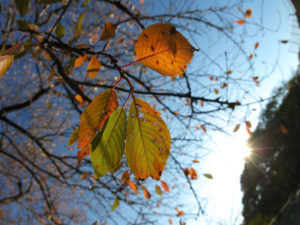
Content
- 1 How to care for cherries in the fall to properly prepare for winter
- 2 Autumn feeding of cherries after fruiting
- 3 Autumn pruning of cherries
- 4 Eradicating autumn spraying of cherries from diseases and pests
- 5 How to whitewash cherries in autumn
- 6 Autumn water-charging irrigation
- 7 How to properly cover cherries for the winter: protecting young trees from rodents, sunburn
How to care for cherries in the fall to properly prepare for winter
So, the main autumn activities for preparing cherries for winter include the following:
- autumn feeding;
- autumn pruning;
However! Usually, cherries are cut in the spring, and not in the fall, so we suggest you read this article about how to shape and prune cherries in spring.
- cleaning the trunks from old dead bark, various mosses and lichens;
- cleaning the tree trunk circle from plant and other debris (it is possible before processing, and it is possible after);
Important! If the tree does not hurt, then garbage (except for fallen fruits) can be thrown onto the compost heap. But if it hurt, then the plant residues must either be burned, or bury very deeply, or simply taken out from the site.
- eradicating autumn treatment from diseases and pests;
- whitewashing of trunks (necessarily after processing).
Advice! All about autumn whitewashing fruit trees (including cherries) described in detail in this material.
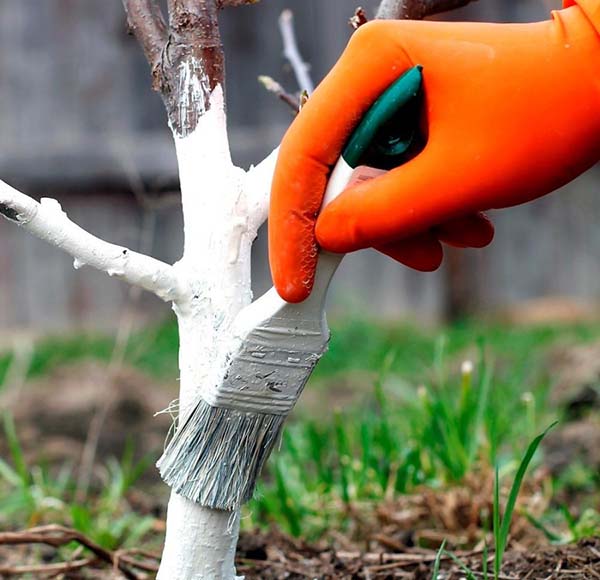
- autumn water-charging watering and digging of the earth in the near-trunk circle;
- shelter for the winter (more precisely, protecting a young tree from rodents, sunburn and damping of the root collar).
Next, we will take a closer look at each of the autumn cherry care activities that need to be carried out after fruiting and harvesting.
Autumn feeding of cherries after fruiting
Obviously, sweet cherries during this period require typical autumn fertilizers, precisely speaking, potassium-phosphoric.
Note! In no case you can't feed in the fall nitrogen fertilizers (like urea or ammonium nitrate).
You should also know that all stone fruit crops (which include cherries) take a lot of calcium from the soil to build their bones, therefore, it is very advisable to periodically feed cherries with calcium fertilizers, for example, dolomite flour (which also deacidifies the soil).
By the way! The site already has a separate article about how to feed cherries and cherries in autumn (after fruiting and harvesting).
Top dressing for better ripening of shoots
If at the beginning of autumn you see that young cherries planted this spring, the shoots are still quite green, i.e. unripe and not lignified (and such shoots simply cannot overwinter and will necessarily freeze out), then to speed up their ripening (in winter they should go brown) you must without fail foliar top dressing (spray with a solution on the sheet) with phosphorus-potassium fertilizer (optimally - potassium monophosphate).
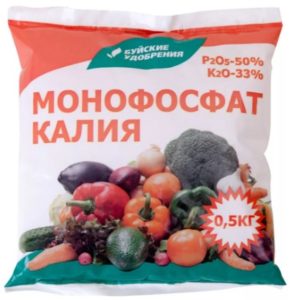
By the way! For ripening cherry shoots, it is also used summer chasing or trimming... In this case, the length of the young growth should not exceed 40-60 cm, everything else must be cut off.
Autumn pruning of cherries
Most experienced gardeners agree that all fruit trees, including cherries, are recommended to be cut in the spring, and not in the fall.
Autumn pruning is dangerous for fruit trees: the cuts do not have time to grow and prepare for low temperatures, as a result, during severe frosts in such places, the tree freezes out.
There is also a common, but not indisputable rule that in the fall you can cut pome trees, but stone fruit trees only in the spring.
By the way! The site has a detailed article about how to shape and prune cherries in spring.
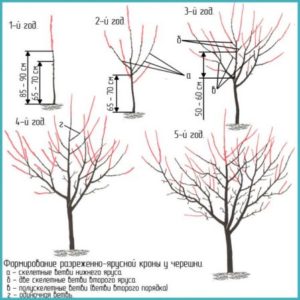
But in general, in the fallusually spend only sanitary pruning of cherries, i.e. get rid of dry, broken and diseased branches (especially affected moniliosis, which have a monilial burn).
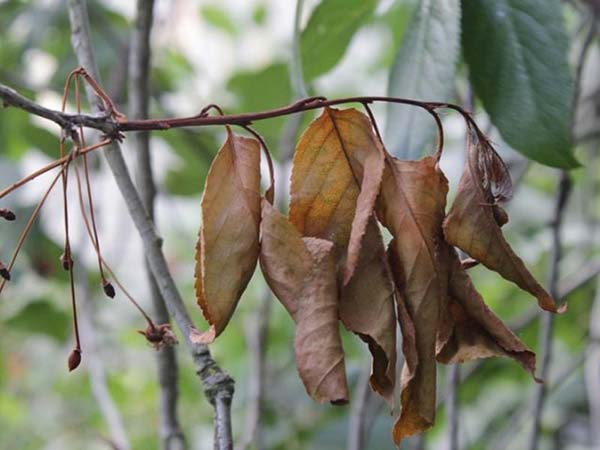
Eradicating autumn spraying of cherries from diseases and pests
The purpose of this autumn processing of cherries is to get rid of all remaining pathogenic fungi and insect pests (including their eggs) so that they could not overwinter on / in the bark and near-trunk circle (in the soil).
Advice! The site has a separate detailed article about when and how to properly carry out the autumn eradicating spraying of the garden from diseases and pests.
As for the timing of the autumn eradication spraying, here some of the gardeners are convinced that it is better to carry out treatment against pests and diseases after leaf fall, when the tree goes into a state of dormancy, its buds will completely "close" and become inaccessible to the ingress of powerful and strong solutions, which we will spray the tree. Others believe that it will be even more effective to process trees just before leaf fall (2-3 weeks before), i.e. even on the leaves, but always after fruiting and harvesting. In this case, the leaves will quickly turn black and, as it were, "burn", but do not be afraid: this is how it should be.Due to this (loss of leaves), the tree will begin to prepare more actively for winter.
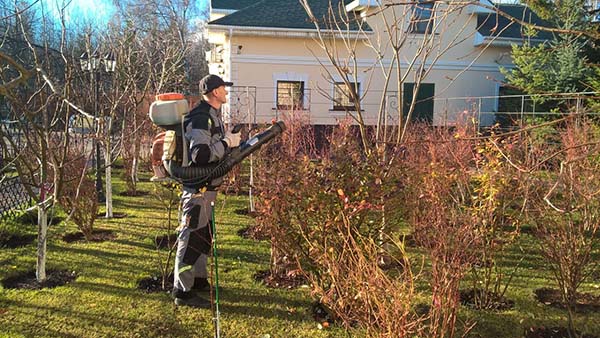
However, it is also not worth delaying too much: it is important be in time before the onset of stable frosts, otherwise the preparations (fungicides and insecticides) simply will not work and the procedure will become meaningless (as a rule, most agents are effective at temperatures up to +5).
As a means for autumn tree processing, they are most often used inkstone in combination with urea or Bordeaux liquid.
Advice! The site already has detailed material about when and how to treat fruit trees and shrubs in the fall from diseases and pests.
Video: autumn eradication spraying
By the way! If in the summer you noticed that the leaves and fruits on your cherries have dried up, they are hanging as if "burned", then just know: this monilial burn (moniliosis).
Autumn processing also helps from the disease. bordeaux liquid or simply copper sulfate (but they are better off in spring).
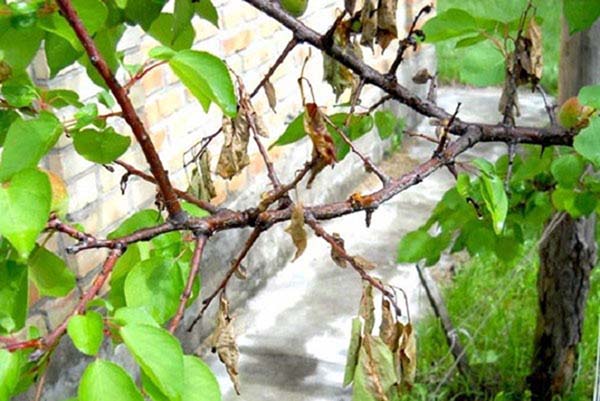
Video: how to spray cherries in autumn from moniliosis
Note! If you spent autumn spraying on cherries from diseases and pests, this does not mean that to spray in early spring you don't need it anymore. How much more necessary! Autumn eradication spraying actually similar to early spring garden processing (the very first, it is also called eradicating).
How to whitewash cherries in autumn
The purpose of the autumn whitewashing of any fruit trees (including cherries) is prevention of frostbites (sunburn), cracks on the bark, which are formed due to temperature changes (plus-minus, plus-minus) in the transitional winter-spring period (in February-March).
Note! Whitewashing in the spring (April-May) does not make any senseapart from the aesthetic.
It's another matter if you come to the dacha in late February or early March and whitewash. But is this possible if you are a city dweller?
Accordingly, it is necessary to whitewash old trees, and especially young ones. Moreover, to whitewash the trunks of young seedlings, weaker solutions should be used (if you use lime, then its concentration should be reduced by 2 times) so as not to burn the young bark. Or you can use special paints for whitewashing garden trees: buy the same water-based or water-based paint, or acrylic paint. In any case, it is imperative to whitewash, since young seedlings have a very thin bark, which can be quite easily damaged in late winter or early spring from sunburn (it simply bursts due to temperature differences).
By the way! The site already has an article about when and how to whitewash fruit trees in autumn (all trees are whitened in the same way).
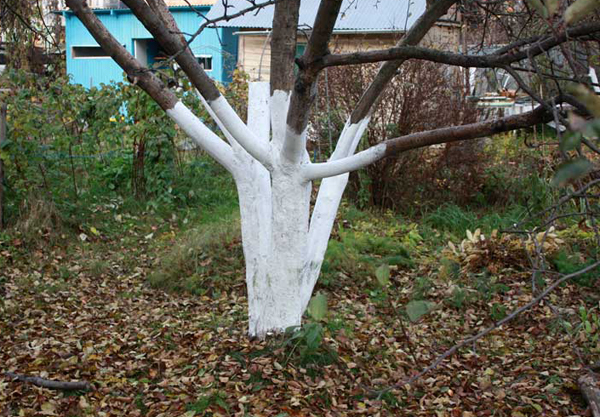
By the way! There is a not unfounded opinion that very young seedlings with smooth bark it is better not to whitewash, but to wrap the barrel with white covering material (spunbond ribbons)... So you not only prevent sunburn, but also protect the seedling from rodents (more on this in the next paragraph).
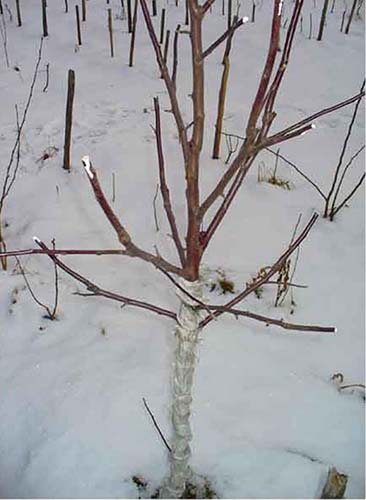
Autumn water-charging irrigation
It is also called "water-charging" irrigation or "winter" irrigation.
Autumn water-charging watering of cherries is another useful activity that allows you to better prepare the tree for winter by “filling” it with moisture. The fact is that moist soil freezes less and has greater thermal conductivity, in other words, the heat from the lower layers of the soil will warm up the roots of your cherry in the cold period.
Thus, water-charging watering is recommended for all fruit trees and berry bushes.
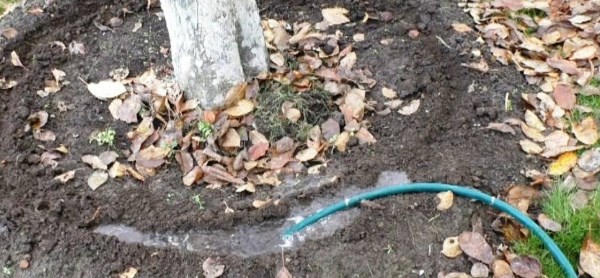
How long does it take?
- With the beginning or after the fall of leaves, on the eve of cold weather (at a positive temperature).
When is winter watering especially necessary?
- In case you have sandy loam soil and autumn does not indulge in frequent and heavy rains, and winter is not snowy.
It is worth understanding! Of course, if the autumn is very rainy, then you can completely do without water-charging irrigation.
How much water is required?
- Approximately 40-100 liters of water per 1 square meter of the trunk circle (for young - 40-50 liters, for adults - 80-100 liters), i.e. you need to calculate the area according to the crown projection (its perimeter). The more mature and massive your tree is, the more water you need: from about 50 to 200 liters.
Advice! Naturally, you don't need to carry any buckets: take the hose and move it around the trunk circle (and first measure how many minutes it takes to get one 10-liter bucket. For example, if in 30 seconds, then 5-10 minutes will be enough).
And after watering (for example, the next day) it is very desirable also loosen the soil in the near-barrel circle, because loose earth freezes less.
Of course, if you have a good layer of sod under the trees or grass (lawn) just grows, then you do not need to touch it.
Video: what is water-charging irrigation and how to carry it out correctly
How to properly cover cherries for the winter: protecting young trees from rodents, sunburn
So we got to the final autumn event to prepare cherries for winter.
Of course, adult cherries do not need any shelter for the winter.
Another thing is that a young cherry seedling planted this spring or even more so in the fall, some protection will be required, and not from frost, but from rodents and hares, as well as from sunburn (which was also described in detail in the paragraph on autumn whitewashing).
To protect young cherries from hares and rodents (the same mice) that like to gnaw the bark, you need wrap (more precisely, bandage) the lower part of the trunk from the ground itself to the skeletal branches special protective non-woven (i.e. breathable) material, for example spunbond or lutrasil, burlap (but by no means a film, otherwise your tree underneath it will shake out).
Important! If you wrap the barrel, then in this case you even no need to whitewash the treesince the white non-woven fabric will have a protective function to prevent sunburn (i.e., will act as a sun reflector).
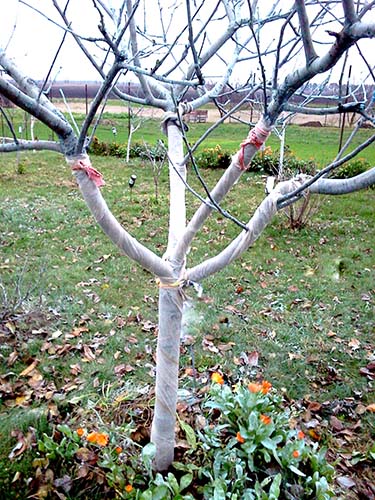
Or you can buy finished tape for wrapping trunks of fruit trees for the winter.
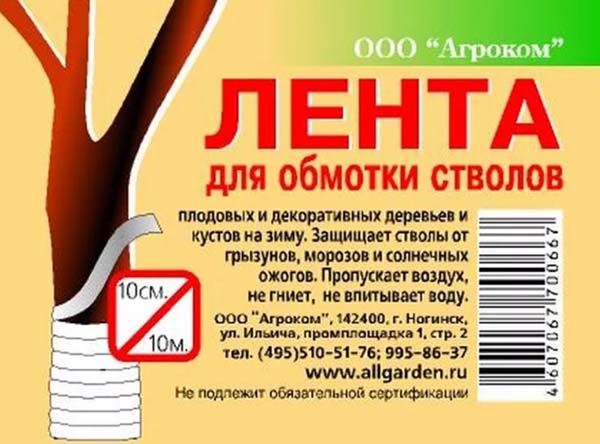
And some gardeners even erect similar structures.
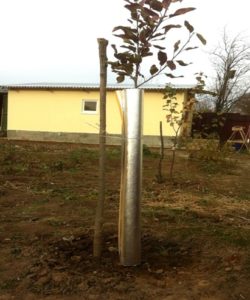
Advice! If rodents or hares have seriously damaged the bark of your cherry, so to speak, gnawed with a ring, then in order to save the tree, you will need it plant in spring with a bridge, which is described in detail in this article on grafting plums (for cherries, everything is the same, because the cultures are stone fruits).
Video: sheltering cherries for the winter
Another significant problem when growing cherries in a "damp" climate is damping of its root collar. Therefore, in the fall, it (the root collar) is necessarily freed from excess mulch and, for example, for additional protection, the lower part is covered with mastic varnish, in order to surely protect it from excess moisture and subsequent damping.
Thus, proper autumn care for cherries will allow you to harvest a bountiful harvest of delicious and sweet berries again next year. The main thing is not to be lazy! Not that all this is energy consuming.
Video: how to properly prepare fruit trees for winter

